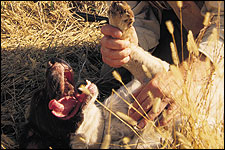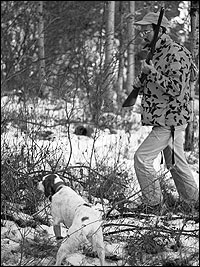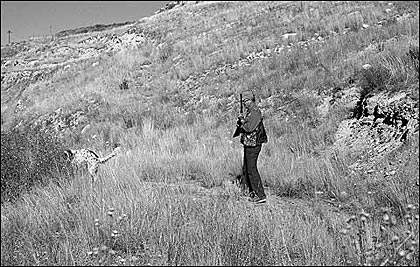A Dog's Pads Are Important--Take Good Care Of Them.
By Dave Carty
The original idea was to exercise the dogs. There's a mountain range I can see from my living room window, and a friend, who was training for a marathon at the time, planned to run to the top of it. He wanted some company, so he invited me. My dogs came along for the ride.
Don't get the wrong idea. I'm in fair shape, but there was no way in hell I was going to run to the top of a 9,000-foot mountain. Still, a brisk climb sounded like fun, and with the hunting season three months away, it was time to get the bird puppies out of the house and into the field.
The dogs were in heaven that day. Is there anything happier than a dog with the wind in his face? Fancy, my little Brittany, raced across the talus slopes with my year-old setter, Rabbit, hard on her heels. My buddy was long gone by the time we reached the top, so we returned to the trailhead on our own. I noticed then that Rabbit was picking her way through the rocks along the trail, but it didn't seem like a serious problem at the time, so I ignored her.
The following morning, Rabbit wouldn't get up. She seemed happy enough, and thumped her tail on the rug, but she wouldn't move. Finally, when I nudged her a bit, she reluctantly rose to her feet, then minced toward the front door. I was horrified. What had happened to my little pup? I ran my hands along her legs and could find nothing awry--no broken bones, no tender spots. Then I examined her feet. All four pads were crusted with dried blood. Here and there, red patches of raw skin peeked through the scabs.
That was my introduction to pad damage in hunting dogs. I'd had bird dogs before, of course, including a crazed springer spaniel whose m.o. had been to run through things rather than around them, with concomitant damage to his body. But I'd never had a dog suffer pad damage like this. For the next three days, I literally had to carry Rabbit outside every morning, then carry her back in again. Fancy, on the other hand, had no damage to her pads whatsoever.
What I was able to deduce from that incident is that some dogs have soft feet and others don't. If your dog does, you will have undoubtably discovered that by the end of his first season, although it's conceivable that those of you who live in the soft, deep topsoil regions of the midwest could go years without major problems. Tender feet are tough to predict. Although some have told me that setters are prone to sore pads, I know plenty of setters with pads like boot leather (not mine, though). Nor do I think the color of the feet is much of an indicator. My Brittany's pads are pink, supposedly the "softest" color, and her pads are as tough as nails.
 Thorns and other hazards can disable a dog. The author found a piece of thorn in his dog's pad after the hunt. |
There are attachments you can buy that will allow you to attach a leash to a bicycle and supposedly make roadwork safe and easy, so I bought one. Only problem was, Rabbit refused to run. Instead, she'd hang in her harness until I was pulling her instead of the other way around. The upshot, naturally, was another case of torn up pads and another 10 days of recovery time. For my dogs, at least, I've found that the best way to get them to run is simply to take them in to the country and turn them loose. Most bird dogs are so happy to be out they'll give themselves a decent workout as long as you're walking with them.
No doubt about it, however, running helps toughen a dog's feet, particularly if your dog is running on concrete or asphalt (this can lead to joint problems in some dogs, however, so don't overdo it). A year ago, I seized upon the notion of "road work" for my animals.
The biggest factor in torn up pads is rough, rocky country, and if you happen to hunt in rough, rocky country like I do, sore pads may well become a recurring occupational hazard. Perhaps the worst offender is the volcanic rock found in some parts of Utah and Idaho. I've yet to hunt in this stuff (although I probably will, because that's where the chukars live), but I've backpacked over it, and even with the densely lugged Vibram soles on my hiking boots, the stuff makes me cringe. Yet dogs can and do hunt in this kind of terrain, including a heavy-set Lab belonging to a friend of mine, whose input you'll read in a moment.
Cactus, while not posing the problem to pads that rough ground does, can still be highly aggravating (not to mention painful) for any dog that steps in it. Fancy, who years ago must have had a run-in with a cactus patch, will now tiptoe across exposed, rocky hillsides, the place she knows cactus grows thickest. My setter, on the other hand, will race full tilt through cactus patches without paying the slightest bit of attention to where she's going, but I've yet to yank a spine from her tender paws. Go figure. Last on the list of problems is crusted-over snow. A hard freeze that follows a warm spell can form enough of a crust that it will occasionally lacerate a dog's pads.
 Crusty snow can present a hazard for your dog. |
More commonly, though, dogs that hunt in snow will gather balls of ice between their toes, which they'll stop periodically to chew out. Although the balls of ice don't seem to hurt the dog's feet, on bad days it can slow their hunting dramatically. When I was hunting Montana ruffs more than I do today, my long-haired springer had an ongoing problem with iceballs. I tried trimming the hair from between his toes (not as easy as it sounds), but it never seemed to do much good. I never did arrive at a satisfactory way of dealing with the problem.
What can you do to keep your dog on his feet and pain free? There's no substitute for ongoing awareness of your dog's physical condition. Had I paid attention to Rabbit's distress during the hike described at the beginning of this article, I might well have limited the damage to her feet and shortened her recovery time. It's taken me a few years and a couple dogs to realise that a good bird dog can hunt vigorously while simultaneously enduring considerable pain. Any limp should be examined immediately. Abraded pads may not slow down a hard-charging pointer on the day the injury occurs, but it may well put the same dog completely out of commission the following morning. Other dogs, of course, may just shrug off the pain and keep going until they hunt too much to walk. It's up to you to make the call on whether or not to keep
him in the field.
Removing thorns is generally simple. I carry a pair of needle-nose pliers in my vest and a pair of hemostats in my first-aid kit, and between the two, I can usually pull any cactus thorns that may have worked their way into the dog's foot. It's important to get to them as soon as the dog begins limping, however, or the thorn may break off flush with the skin and become almost impossible to find. Although I haven't had a big problem with broken cactus spines or thorns yet, I did have a somewhat similar situation years ago. The injury-prone springer I mentioned earlier stuck his nose into a dead porcupine and got a snoot full of quills. I worked him over with the hemostats and thought I had removed them all. Almost a year later, when the dog developed a swelling on his jaw, I took him to a vet who found an infected section of quill I'd missed. The lesson here, I suppose, is that it's best to have a vet remove porcupine quills. But I also wonder if, in a similar way, missed thorns or cactus spines could stay in a dog's leg and cause headaches later.
If caught soon enough and treated properly, sore pads do not always rule out hunting your animal. Rick Allen, a vet and an old high school chum, hunts his Lab in the volcanic uplands around his Jerome, Idaho, home and over the years has gained plenty of experience with sore pads on dogs. He claims that a tube of super glue--which I also carry in my first-aid kit for minor suturing jobs--will keep a dog on his feet. He suggests running the dog for an hour or two, then, before the pads have worn badly, applying a thin coat of the glue with a finger. For pads with more wear, he suggests cutting moleskin to fit, then booting the dog. I have yet to try this last technique, but moleskin has worked on my own feet for decades.
 The rocky terrain of the West is especially hard on a dog's feet. |
Pad Tuf, an aerosol sprayed on the bottom of a dog's foot works. I used the stuff on and off for years with very little success until I finally read the instructions, which suggested I apply Pad Tuf only twice weekly. I have since learned that if I spray a dog's foot twice weekly for at least two weeks prior to heavy use, the dog's pads gain significant protection. On the other hand, spraying his feet a day or two before use seems to have little effect. Evidently, Pad Tuf helps create tough pads over time. Spray it outdoors if you can--the fumes are terrible. Hold your dog down for the couple minutes the spray takes to dry.
Dog boots can be a big help. In the last couple of years, I've used a couple of styles and both had their good points. Lewis makes rubber dog boots tough as tin that will undoubtably allow a tenderfooted dog to hunt all day in rough terrain. But the Lewis boots, like the only other brand I have tried, do not always stay on a dog's feet. My biggest problem came from an improper taping job, which I take sole responsibility for. Rather than tape the dog's leg first, as the instructions suggested, I put the boots on Rabbit's feet and then taped over them with athletic tape. The boots wore huge holes in the sides of her legs which took weeks to heal. Since she had already blown out her pads and I had a Kansas quail-hunting trip coming up, I bought another set of leather and nylon boots, which she promptly threw. The manufacturer kindly replaced the entire set, and when I placed those on her feet, she threw them again.
For some reason, these boots, which were bright yellow and easy to spot on a running dog in thick cover disappeared without a trace on the wide-open prairie. Despite my chronic inability to read directions, however, once I figured out the proper way to fit dog boots, they made a big difference in keeping my setter hunting. Although you may be able to keep your dog hunting with boots, super glue and care, a dog with pad injuries will eventually need time to recuperate. Fortunately, it doesn't take long for moderately abraded pads to heal, so if you've got the time, give your dog a break for a week or so. Then keep an eye on him. Preventing sore pads is still better than any cure applied after the fact.






